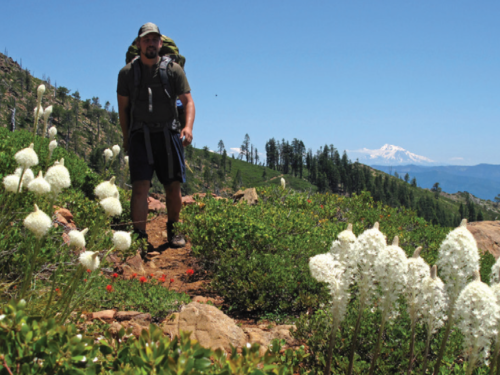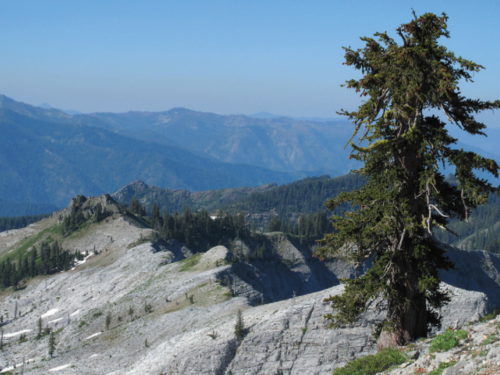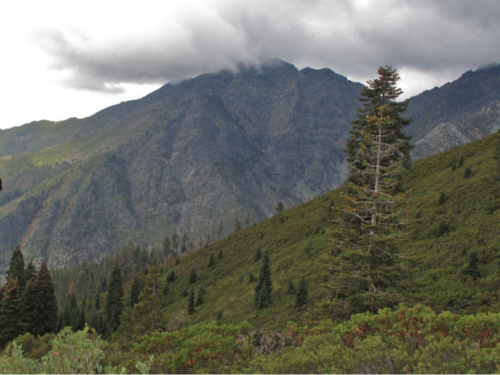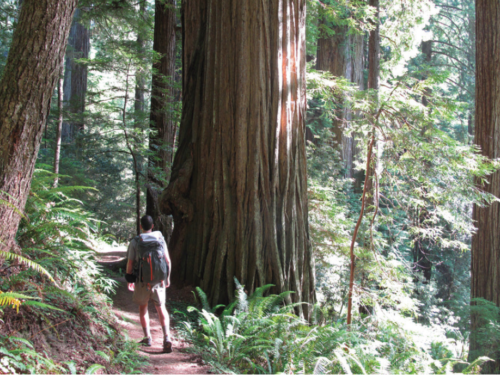Conifers
of the California Mountain Trails
By Web Editor
April 13, 2020
Discover the immense diversity of conifers in Northern California's Klamath Mountains.

A
conifer panorama: Allison Poklemba (far right), climbs to the highest
point on the Bigfoot Trail at Packer’s Peak in the Trinity Alps
Wilderness
In
2009, just after the school bell rang for the last time that year, and
my 30 seventh grade students ran out the door for summer, I jumped into
my car and headed to the Mendocino National Forest in Northern
California to start the first-ever, official thru-hike of the Bigfoot
Trail.
I am the first person to plan, map, and hike the Trail,
which I created by connecting existing trails and Forest Service roads. I
decided to name it after Bigfoot, also known as Sasquatch, the large
and mysterious creature purported to inhabit the mountains in this part
of the country.
A thru-hike is a hike on an established
end-to-end, long-distance trail, with continuous footsteps, that is
completed within one calendar year. Over the next 20 days and 360 miles,
I walked, mostly alone, on my way across the Klamath Mountains to
Crescent City, CA.

The
Bigfoot Trail follows the Boundary Trail through the Red Buttes
Wilderness along the California-Oregon border. Dr. Jeffrey Kane is seen
here on the Boundary Trail
A Hike Amongst the Conifers of Klamath Mountains
I
first cooked up the idea of this hike in 2007 with my friend, mentor,
preeminent botanist, and conifer expert, John O. Sawyer. We envisioned
it as a way to connect existing trails, roads, wilderness, and botanical
wonders across the Klamath Mountains.
This project would combine
hiking and natural history by defining a new thruhike in one of the
most speciesrich, temperate, coniferous forests on Earth. North America
holds two of the most species-rich, temperate forests in the world:
those of Southern Appalachia and those of the Klamath Mountains.
What
do these locations have in common? Glaciers and seas did not completely
cover them during the Cenozoic Era, and the mountains were monadnocks,
or islands above the plains, offering temperate refuges to plants and
animals over time. Both locations have historically maintained a
moderate climate.
Conifer Diversity in the Californian Klamath Mountains
These
areas are beyond the southern terminus of the enormous continental ice
sheets of the Pleistocene Epoch (commonly called the Ice Age). Some
plants undoubtedly remained in these regions through historic climatic
change, while other species repeatedly moved in as the climate cooled,
and the glaciers pushed southward, or, then, species moved out and
followed other glaciers northward.
These dynamic fluctuations
have cradled plant diversity in these two unique regions. The current
consequences of these historical patterns are that the Klamaths and the
Southern Appalachians have grand floristic diversity, a concentration of
endemic plants, and a fundamental importance to the forest floras of
nearby regions.
Per unit area, the Klamath Mountains and the
Southern Appalachian Mountains hold more plant taxa than any others in
North America. Plant genera such as Cornus (dogwood), Asarum (wild
ginger), and various conifers (Pinus, Abies, Thuja, Chamaecyparis) grow a
continent apart, while providing a comparative glimpse of ancient
floras.

The heart of the
Marble Mountain Wilderness is Marble Mountain itself, sprinkled with the
rare California-endemic foxtail pine (Pinus balfouriana)
A Conifer Botanical Museum in the Mountains
Complex
interactions between biotic and abiotic factors have encouraged and
nurtured biodiversity in the Klamath Mountains over millions of years.
The region is a botanical museum, hiding relicts of epochs gone by,
which are called paleoendemics,
such as Brewer spruce (Picea breweriana).
The region is also a cradle, promoting the adaptive evolution of new species, which are called neoendemics,
like Baker’s cypress (or Modoc cypress, Cupressus bakeri). Complex climates and soils nurture biodiversity. The area also has a central location and continuity
with other mountain ranges along the Pacific Cordillera.
Across
this landscape, a mosaic of habitats mix at a crossroads of five biotic
regions—Cascade Range, Oregon Coast Range, Great Basin, Central Valley,
and Sierra Nevada—each helping
to define the Klamath Mountains.
Within the geologic
boundaries defining these complex habitat mosaics of the Klamath
Mountains, there are approximately 3,540 taxa (species, subspecies, and
varieties) of vascular plants and up to 38 species
of conifers, depending on how one delineates the region. In addition
to plants, the region holds exceptional diversity in amphibians,
mammals, and birds.

Michael Kauffmann surveys the final climb up the Bear Creek Trail into the Trinity Alps Wilderness
A Glimpse of an Older Coniferous Forest
In
the Tertiary Epoch, beginning around 65 million years ago, a temperate
forest prevailed here, unlike any other in the history of the Earth. In
this Arcto-Tertiary forest, as it is called—existing on a landmass that
would soon become North America, Europe, and Asia—a blending of conifers
and broad-leaved trees dominated the landscape.
With continental
drift and climate change, the offspring of these great forests became
fragmented. Over time, ice ages came and went, causing a change in
flora, as increasingly dry conditions became more common.
The
descendants of the Arcto-Tertiary forest became less extensive and more
isolated. These progenitors remained, finding refuge in the higher and
cooler regions that maintained a climate more similar to that of the
early Tertiary—in what we now call northwest California and southwest
Oregon.
Here, today, we glimpse a forest that is similar to those
of the earlier epoch. Holdouts include, but are not limited to, Brewer
spruce, Lawson cypress (Chamaecyparis lawsoniana), coast redwood (Sequoia sempervirens), California pitcher plant (Darlingtonia californica), and Kalmiopsis (Kalmiopsis leachiana).

The
final segments of the Bigfoot Trail pass through Jedediah Smith
Redwoods State Park, here in the Stout Grove. Seen here is Ian Nelson
walking among the redwoods
The Bigfoot Trail
The
Bigfoot Trail highlights the immense ecological diversity of the
ancient forests of Northwest California and other unique landscapes by
connecting existing trails and remote Forest Service roads. It passes
through the hamlets of Hayfork, Junction City, Seiad Valley, the town of
Crescent City, and gets close to Etna and Hiouchi.
Trekkers from
all over the world have hiked either parts or all of the trail since
2009, with at least 40 thru-hikers having completed the route. These
folks not only bring monetary rewards to local communities, but also
leave with a love for this unique region, as they venture on a conifer
treasure hunt.
There is now a non-profit organization overseeing
the establishment of the route. The Bigfoot Trail Alliance is a 501(c)
(3) that is working to support the establishment and maintenance of this
360-mile route through the Klamath Mountains. The BFTA fosters a
community committed to constructing, maintaining, promoting, and
protecting—in perpetuity—the Bigfoot Trail.
Visit the Bigfoot Trail website
to learn more about the trail and the mission of the organization.
After the Summer 2019 ACS National Meeting in Oregon, the American
Conifer Society became a partner with the Bigfoot Trail Alliance. For
that, we thank you all!
Text and photographs by Michael Kauffmann/Bigfoot Trail Alliance.
 WR Director
WR Director ACS Treasurer
ACS Treasurer CR President
CR President WR President
WR President ACS President
ACS President ACS Secretary
ACS Secretary CR Director
CR Director SER Director
SER Director SER President
SER President